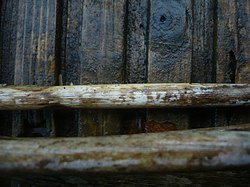Acantobasidium-Minimum-Evolution-Tree
Figure: Evolutionary relationships of Acanthobasidium
The evolutionary history was inferred using the Minimum Evolution method. The optimal tree with the sum of branch length = 0.16830866 is shown. The percentage of replicate trees in which the associated taxa clustered together in the bootstrap test (1000 replicates) are shown next to the branches. The tree is drawn to scale, with branch lengths in the same units as those of the evolutionary distances used to infer the phylogenetic tree. The evolutionary distances were computed using the Maximum Composite Likelihood method and are in the units of the number of base substitutions per site. The ME tree was searched using the Close-Neighbor-Interchange (CNI) algorithm at a search level of 2. The Neighbor-joining algorithm was used to generate the initial tree. The analysis involved 14 nucleotide sequences. All positions containing gaps and missing data were eliminated. There were a total of 813 positions in the final dataset. Evolutionary analyses were conducted in MEGA5. All sequences were obtained from the GenBank and were aligned by the Muscle algorithm with standard settings.
- List with GenBank Sequences
- Aleurodiscus grantii strain T541
- Aleurodiscus grantii strain T569
- Aleurodiscus amorphus strain HHB15282
- Aleurodiscus amorphus - AF506397
- Acanthobasicium penicillatum strain T322
- Aleurodiscus weirii strain FP134813 - AY039308
- Aleurodiscus weirii strain HHB12678
- Acanthobasidium norvegicum strain T623
- Acanthobasidium phragmitisstrain CBS233.86
- Acanthobasidium aurantius strain T621
- Neoaleurodiscus fujii strain Wu0807-41
- Neoaleurodiscus fujii strain Wu0807-40
- Aleurocystidiellum disciforme strain T529
- Aleurocystidiellum disciforme strain T629
Relevante Bilder
Relevante Artikel
AcanthobasidiumAcanthobasidium ist eine Pilzgattung innerhalb der Familie der Schichtpilzverwandten (Stereaceae). Die Pilze haben sehr dünne, flach ausgebreitete Fruchtkörper, ornamentierte Sporen, ein monomitisches Hyphensystem und Hyphen mit Schnallen. Typisch für die Gattung sind Acanthobasidien. Die Pilze wachsen meist auf abgestorbenen Gräsern oder toten, krautigen Pflanzen und erzeugen eine Weißfäule. Die Typusart der Gattung ist Acanthobasidium delicatum. .. weiterlesen

